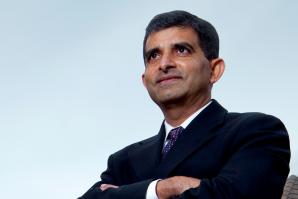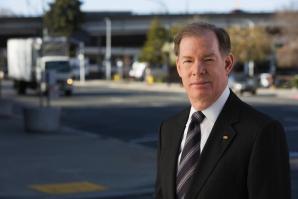There’s an old joke that no two economists can agree on the economy, but as the nation, California and the Capital Region continue to weather the worst downturn since the Great Depression, economists are showing remarkable solidarity: They think we’re in a mess.
The most prevalent prediction says the graph charting 2008 through 2011 will look like an “L” — a sharp drop in 2008 followed by years of growth that could be anemic and vulnerable to aftershocks.
“I view this as a period of a number of years of difficult transition,” says Desmond Lachman, resident fellow at the American Enterprise Institute for Public Policy Research. “When you have a major financial crisis as we’ve had in the U.S. and globally, one doesn’t get a recovery fast. When you do get it, it’s weak and there are struggles all along the way.”
There are bright spots, but the driving factors behind the recovery are many and will feed into one another, fostering a tremendous amount of uncertainty. Taken together, they comprise the parameters of the new economic “normal” for the foreseeable future.
Consumers saving more of their money will play a big part.
In a November speech, Janet Yellen, president of the San Francisco branch of the Federal Reserve Bank, said the personal savings rate in the U.S. averaged 4 percent in 2009, up from almost zero in 2008, and is likely to increase. Fears of job loss appear to be the greatest incentive, along with massive hits to retirement plans, anticipated higher taxes, stagnant or reduced wages and a desire to pay off debt.
Increased savings certainly makes sense, but such a sharp and sudden rise in savings translates to proportionate drops in consumption and demand. That, in turn, places more pressure on employers to trim costs through layoffs, cuts in wages or benefits and reduced hiring.
That feeds into another hallmark of the new norm: continued high unemployment.
“I don’t think the unemployment issue is going to go away quickly,” says Barry Bosworth, senior fellow at the Brookings Institution. “The private sector can’t hire without an increase in demand, and public sector job creation efforts are only short-term solutions.”
The economic-glass-half-full types see some cause for celebration because unemployment growth has slowed. There is also a recent Manpower Employment Outlook Survey reporting 73 percent of U.S. employers — the highest percentage in the survey’s history — aren’t planning any staffing changes for the first quarter 2010. But that’s only good news for people with jobs, however. The news is countered by a Business Roundtable survey that says more of America’s largest companies would shrink their staffs rather than hire in the next six months.
“Even if God made it rain money all over the state, we’re still going to see more layoffs, furloughs and continued budget deficits.”
Sanjay Varshney, dean, College of Business Administration, Sacramento State University
No one’s declaring where the national unemployment level will peak, but estimates published in the July 2009 Sacramento Business Review predict unemployment will hit 11 percent nationally in 2010, with a corresponding rate of 14.5 percent in California and 13.5 percent in the Sacramento region.
A third marker of the new normal is low inflation. That may seem positive, but the exceptionally low inflation rate witnessed today, bordering on deflation, has experts worried.
“When you get deflationary pressure in this kind of environment, that means employers can’t charge prices high enough to stay in business,” says Sanjay Varshney, dean of the College of Business Administration at Sacramento State University. “That could force many of them to close, costing jobs and pushing us even deeper into recession.”
Core prices rose by 1.25 percent between November 2008 and November 2009, well below what the Federal Reserve considers appropriate for long-term price stability, according to Yellen. She predicts that, with wages remaining stagnant, the core inflation rate could be even lower over the next few years.
Another component of the new economy will be the level of government involvement. Not counting health care reform, more than $1 trillion in federal funding has been committed or spent from the $700 billion bank bailout of 2008, the $787 billion stimulus of 2009, and a possible federal jobs bill with an estimated price tag of $200 billion. Still, some economists think more may be needed.
“I don’t see any way the economy will bounce back of its own accord, it’s going to require economic policy,” says Dean Baker, co-director of the Center for Economic Policy and Research in Washington. “It doesn’t just have to be infrastructure either. With the right economic policy, we could get out of this very quickly.”
Here, economic opinions begin to significantly part ways, though one area of general agreement is that public employment programs are not sustainable. Resources are not unlimited, and when infrastructure projects are completed, there may not be new projects for those workers.
“Rather than an L-shaped recovery, we could be looking at a sort of ‘W,’” says David Hosley, president of the Great Valley Center in Modesto. “Unfortunately, the top of the W’s right leg won’t get to the same level the top of left leg was for a long time.”
“It’s going to be a slow crawl back to positive territory for at least the next 24 months.” —Ryan Sharp, director, Center for Strategic Economic Research
Finally, despite some positive news, the banking industry remains largely dysfunctional. The credit crunch, which has plagued the economy for more than a year, is likely to continue. Some experts predict the same mistakes that led to the collapse in the residential mortgage industry were also made in commercial lending, and that industry has yet to hit bottom.
“We already know the banks are not honest, so we don’t know for sure how bad off they really are,” Bosworth says. “If they’re really damaged, they’re going to continue to downsize, they’re going to continue to tighten credit, and businesses won’t have access to the capital they need to survive and grow.”
And yet there are positive views out there. Yellen gave a speech in November pointing out that even anemic growth is still growth and highlighting what she called “meaningful upturns” in home sales, the stock market, consumer spending, industrial production and foreign trade.
It’s easy to become overly pessimistic while in the trough. Gary Schlossberg, a senior economist with Wells Fargo and Co., is reluctant to jump on that hearse.
“It’s too early to be talking about L’s or hockey sticks or new normals,” he says. “We could be surprised by a growth recovery, modest to be sure, but there are some coiled springs out there.”
Schlossberg points to pent-up demand being at its strongest level of the past 18 years, 8 to 9 percent gains in productivity, which he describes as unheard of in a recession cycle, and a history of strong economic recoveries despite bleak outlooks.
So what does that mean for the Capital Region? It’s somewhat fitting that “L” comes at the end of “spiral.” Every headwind facing the U.S. economy is exacerbated in the region. As a result, the region is lagging behind the nation in its recovery and will likely continue to see declines across several economic sectors before hitting bottom.
That’s because of problems that are both endemic and systemic to the state. The real estate crash hit California harder than anywhere else, especially in the Central Valley. The state’s higher housing costs, in an environment where loan packages existed purely to get people into homes, led to homeowners and lending institutions being leveraged more than in most other places. California’s generally higher cost of living has also contributed to a higher level of consumer debt, which will likely increase with many households now relying on one paycheck instead of two.
“When you have a major financial crisis as we’ve had in the U.S. and globally, one doesn’t get a recovery fast. When you do get it, it’s weak and there are struggles all along the way.” —Desmond Lachman, resident fellow, American Enterprise Institute for Public Policy Research
Not to be overlooked is a state government incapable of balancing a budget. “Even if God made it rain money all over the state, we’re still going to see more layoffs, furloughs and continued budget deficits,” Varshney says. “We have a structural deficit problem, not a fiscal one, we have to fix. The state itself, usually our safety cushion, is going to be a primary cause of California lagging in the national recovery.”
Sacramento and the Central Valley are more vulnerable to the state’s budget woes than other parts of the state. Furloughs have led to the equivalent of 2,800 lost jobs in the past year, according to the Center for Strategic Economic Research, a Sacramento-based consulting group. Sacramento has a 40-percent exposure to state job losses, compared to 20 percent in other regions. A 10-percent cut in state jobs next year could mean the loss of 30,000 local jobs, which could drive the regional unemployment rate as high as 15 percent.
In addition to continued declines in the public sector, the center is predicting negative job growth in almost every part of Sacramento’s private sector.
“It’s going to be a slow crawl back to positive territory for at least the next 24 months,” says Ryan Sharp, the center’s director.
Two sectors bucking the trend are health care and private education. Sharp says both sectors are continuing to add jobs at a robust rate. That’s not the only positive news either: Job losses across the Capital Region have slowed as well.
To thrive in a new economy, businesses have to recognize they are a component of a global economy, Hosley says. “It’s no longer us vs. San Francisco. It’s us vs. Mumbai.”
And Bosworth agrees, saying it’s time for America to figure out its competitive advantage in the world market. “Unskilled labor is an area where American workers can’t compete on price anymore,” he says. “Our greatest offering is a well-educated and skilled population.”
A looming commercial crisis?
At the national level, a collective wince is brewing on the subject of commercial real estate.
Janet Yellen, president of the San Francisco branch of the Federal Reserve Bank, called the prospects “worrisome” for the sector’s near-term future because of increasing foreclosure rates, plunging property values, downward pressure on rents and increasing vacancy rates.
Unfortunately, lax underwriting standards were not exclusive to the residential market, and, while not as prevalent on the commercial side, they’re likely to do their share of damage.
“Bad loans have been made and losses will be realized in 2010, which is going to be deep trouble for the regional banks,” says Desmond Lachman, resident fellow at the American Enterprise Institute in Washington. “The FDIC has more than 500 regional banks on its ‘troubled’ list already. As the commercial real estate market weakens, we’re to see a banking system that’s already dysfunctional go on life support.”
Although locally we are seeing the dropping rents and rising vacancy that make national observers nervous, a growing bank crisis fueled by the commercial sector is not a foregone conclusion.
“I talk to quite a few lenders, and the definition of what is a bad loan seems to be changing every week,” says John Frisch, managing partner with Cornish & Carey Commercial in Sacramento. “No one can really know what’s coming down the pike, but commercial real estate is going to remain a valuable commodity. I think, for some, 2010 will be a better year than the past couple.”
Recommended For You

New Angle Needed
Sacramento should try a new approach to economic development
Like many transplants to Sacramento, before moving to the area I had little awareness of the plethora of quality-of-life amenities the region has to offer. As I complete my first decade as a resident, it has dawned on me that this has been the longest stop thus far in my professional career.

Active Recruitment
Sacramento needs to attract Fortune 500 companies
As Sacramento gears up to expend precious capital on a new sports and entertainment complex that will bring jobs, outside investment and prestige to the region, I can’t help but ask about other key ingredients needed to guarantee Sacramento a successful future.



